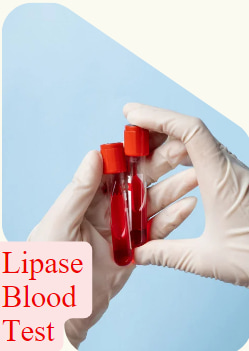Content :
◉ What is lipase blood test?
A lipase blood test is a medical test that measures the levels of lipase enzyme in the blood, also know as lipasemia.
Lipase is an enzyme that helps your body digest fats. Pancreas produces lipase and releases it into your small intestine,where it breaks down the fats in the food you eat.
The lipase blood test is important as it helps in the diagnosis and monitoring of pancreatic disorders. Elevated levels in the blood can indicate pancreatic damage or inflammation.

◉ What is the lipase?
Lipase is an enzyme that plays a crucial role in the digestion and metabolism of lipids (fats). It catalyzes the hydrolysis of triglycerides into fatty acids and glycerol.
Lipases are produced by various organs in the body, including the pancreas, stomach, and small intestine.
◉ What is the importance of the lipase blood test?
The importance of lipase blood test is that it can help diagnose and monitor conditions that affect the pancreas, such as pancreatitis and pancreatic cancer.
The pancreas is an organ that produces enzymes, hormones, and bicarbonate to aid digestion and regulate blood sugar levels. Lipase is one of the enzymes that the pancreas makes to help break down fats in the food you eat.
Normally, only a small amount of lipase is present in your blood, but if your pancreas is inflamed, injured, or blocked, it may release more lipase into your bloodstream. This can cause your lipase levels to rise above the normal range.
◉ How to prepare for the test
To prepare for a lipase blood test:
- You may need to fast for 8 to 12 hours before the test to avoid interference from food.
- You may also need to stop taking certain medications or supplements that can affect the results of the test.
- You should inform your doctor about any medications or supplements you are taking before the test.
- The test itself is simple and involves drawing a sample of your blood from a vein in your arm using a needle.
- The blood sample will be sent to a laboratory for analysis and the results will be reported to your doctor.
◉ Normal levels of lipase in blood
The normal range of lipase varies depending on the laboratory and the method of testing, but it is generally between 10 and 140 U/L for adults under age 60 but for adults over 60, the normal range is 24-151 U/L.
Your doctor will interpret your results based on your medical history, symptoms, and other tests. If your lipase level is higher or lower than normal, your doctor may order further tests to confirm the diagnosis and determine the cause of the abnormality.
◉ High levels of lipase
High levels of lipase in the blood, also known as hyperlipasemia, can indicate a problem with the pancreas or other organs that produce or are affected by lipase.
◉ 1. Causes of high lipase levels
- Pancreatitis : This is a condition where the pancreas becomes swollen and damaged.
- Pancreatic cancer.
- Gallstones.
- Chronic kidney disease.
- Peptic ulcers
- Gastrointestinal disorders.
- Alcohol abuse.
- Medications : Such as indomethacin, birth control pills, and thiazide diuretics.
- Diabetes.
◉ 2. Symptoms of high lipase levels
- Severe upper abdominal pain or back pain
- Fever
- Oily or fatty stools
- Loss of appetite
- Weight loss
- Nausea with or without vomiting
◉ Low levels of Lipase
A low level of lipase in the blood, hypolipasemia, can be an indication of reduced production due to organ failure, which may result from permanent damage to the lipase-producing cells in the pancreas.
◉ 1. Causes of low lipase levels
- Chronic pancreatitis: This is a condition where the pancreas becomes swollen and damaged over time. It can reduce the ability of the pancreas to produce lipase and other enzymes.
- Cystic fibrosis: This is a genetic disorder that affects the lungs and the digestive system. It causes thick mucus to build up in the organs, which can block the ducts that carry enzymes from the pancreas to the intestines.
◉ 2. Symptoms of low lipase levels
- Diarrhea
- Involuntary urination
- Lactose intolerance
- Joint pain / Abdominal Pain / Gallbladder Pain
- Cystitis
- Skin problems like acne and rosacea
- Formation of fat deposits
◉ Additional tests
There are several related analytical tests that can be used alongside the lipase blood test to provide a more comprehensive evaluation of pancreatic function. Here are some commonly used tests:
- Amylase : The amylase blood test measures the levels of the enzyme amylase, which is also produced by the pancreas.
- Imaging tests : Imaging techniques like ultrasound, computed tomography (CT), or magnetic resonance imaging (MRI) can provide detailed images of the pancreas and surrounding structures. These tests can help identify abnormalities, such as tumors or pancreatic duct obstruction.
- Lipid profile : A lipid profile measures various lipids in the blood, including cholesterol and triglycerides. Abnormal lipid levels can be associated with pancreatic disorders and provide additional information regarding lipid metabolism.
◉ Conclusion
The lipase blood test plays a crucial role in the diagnosis and management of pancreatic disorders. It provides valuable information about pancreatic function and aids in the development of appropriate treatment plans.
By working closely with your healthcare provider, you can ensure that you receive the necessary care and support for your pancreatic health.